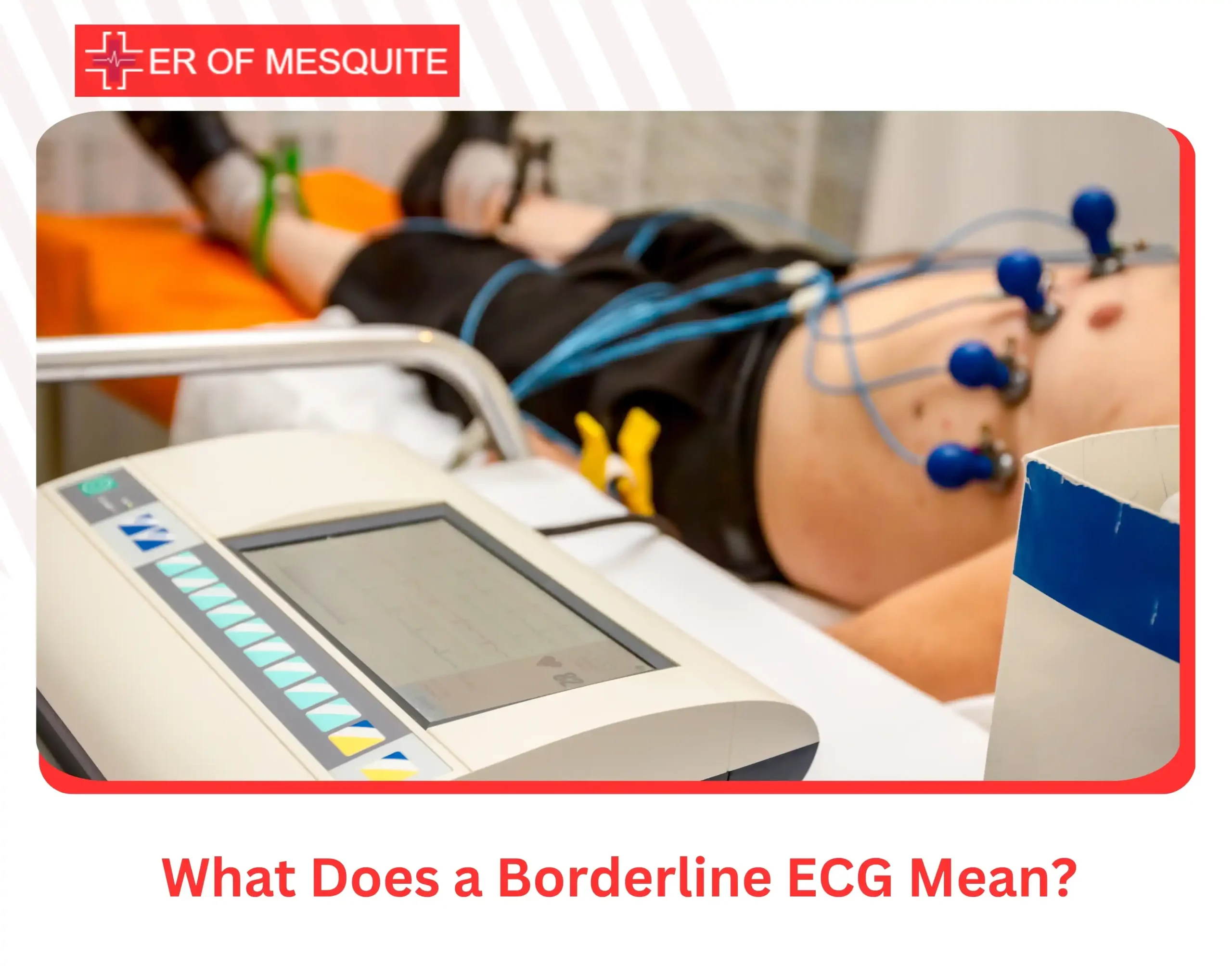When an ECG report comes back as “borderline,” it can leave patients feeling uncertain and uneasy. What does it really mean? Is it harmless or could it signal something more serious beneath the surface?
The borderline ECG meaning isn’t always straightforward. It often falls somewhere between normal and abnormal, showing subtle changes in heart rhythm or electrical activity that don’t clearly point to a diagnosis. For some, it’s nothing to worry about. For others, it’s the first clue in uncovering a hidden heart issue.
Before diving into what causes these findings and what steps to take next, let’s break down exactly what a borderline ECG is and why it matters.
Understanding the Basics: What Is an ECG?
An electrocardiogram (ECG) records the heart’s electrical signals through electrodes placed on the chest, arms, and legs. It produces a visual trace (waveform) that represents each heartbeat and the timing of electrical impulses.
Healthcare providers use ECGs to:
- Diagnose arrhythmias (irregular heartbeats)
- Detect signs of heart damage
- Monitor ongoing heart conditions
- Check the heart’s electrical function before surgeries
To learn more about this, see EKGs: what are they and when should you get them.
What Does “Borderline ECG” Really Mean?
A borderline ECG means that the heart rhythm test result doesn’t clearly fall into either the “normal” or “abnormal” categories. Instead, it shows subtle irregularities or variations that may or may not indicate an underlying heart problem. It’s essentially a gray area on the spectrum of heart readings that requires careful clinical interpretation.
The borderline EKG meaning is not universal, it varies significantly depending on factors like age, gender, medical history, current symptoms, and individual baseline patterns. Some changes may be completely harmless for one person but represent an early warning sign for another. This individualized interpretation is why borderline EKG results require thoughtful evaluation by experienced healthcare providers.
Common Features and Patterns of a Borderline EKG
A borderline EKG shows small differences from what doctors usually expect in a normal heart rhythm test. These slight changes don’t always mean something is wrong with your heart, but they are important enough to take a closer look. Here are some of the most common features that may appear in a borderline EKG:
1. Heart Rate Changes
Minor shifts in heart rate are one of the most frequent reasons someone might get a borderline EKG result. A slower heart rate, fewer than 60 beats per minute, is called sinus bradycardia.
This can be completely normal for athletes or during sleep, but in other people it might signal an issue with the heart’s natural pacemaker.
On the other hand, a resting heart rate over 100 beats per minute, known as sinus tachycardia, might be due to stress, dehydration, or early signs of a heart condition.
2. ST-Segment and T-Wave Changes
These parts of the EKG show how your heart rests between beats. Sometimes they look a little unusual or non-specific, which is another reason a result may be labeled as borderline.
These changes are fairly common and can happen for many reasons such as electrolyte imbalances, certain medications, or early stages of heart disease. By themselves, these changes usually don’t mean there is a major problem.
3. Conduction Delays
Electrical signals guide the heart’s rhythm, and any small delay in their path can show up on an EKG. One example is an incomplete right bundle branch block, which is a minor delay in the electrical flow through the right side of the heart.
This often shows up in borderline EKGs, especially in young or healthy individuals, and usually isn’t a cause for concern.
4. Electrical Axis Shifts
The heart’s axis refers to the general direction that electrical signals travel during each beat. A borderline EKG might show a slight shift to the left or right.
These shifts can be caused by the position of your heart, your body type, or certain lung conditions. Most of the time, if the rest of the EKG looks normal, these shifts don’t indicate an urgent issue.
Borderline EKG vs. Abnormal ECG
The distinction between borderline EKG and abnormal ECG results is crucial for understanding your heart health status and determining appropriate next steps.
| Feature | Borderline EKG | Abnormal ECG |
| Severity | Mild, uncertain significance | Clear evidence of a heart abnormality |
| Diagnosis | May require more testing | Usually indicates a known condition |
| Treatment | Often watchful waiting | May need medication or intervention |
| Prognosis | Often benign | Depends on the underlying cause |
A borderline EKG may simply reflect minor, non-specific variations or even normal aging processes, especially in older adults. On the other hand, an abnormal ECG points more strongly to issues such as arrhythmias, myocardial infarction, or structural heart defects.
Key Steps in Diagnosing a Borderline EKG
Interpreting a borderline EKG result involves a combination of technical evaluation and clinical judgment. Here’s how healthcare professionals assess it:
- Symptom Assessment
Symptoms like chest pain, fatigue, dizziness, or palpitations can determine whether a borderline result is cause for concern. No result should be viewed in isolation.For more on this, explore chest pain relief: safe and effective home remedies. - Comparing With Previous ECGs
Reviewing past ECGs helps identify whether the irregularity is new, chronic, or benign. - Considering Cardiac Risk Factors
Age, blood pressure, diabetes, smoking history, and family background play a major role in interpreting borderline readings. You might also be interested in how to reduce the risk of heart attacks. - Running Additional Heart Rhythm Tests
If the meaning of the borderline ECG remains unclear, your provider may recommend further evaluation, such as stress testing or continuous monitoring.They might also consider a cardiac enzyme test to rule out heart damage.
Follow-Up Tests for Borderline EKG or ECG Results
A borderline EKG result may prompt your provider to take a closer look using one or more of these tools:
- Holter Monitor
This portable device records your heart rhythm continuously for 24-48 hours to catch intermittent issues a regular ECG might miss. - Stress Test
Also known as an exercise ECG, this test checks your heart’s response to physical activity. It can reveal hidden ECG abnormalities that show up under stress. - Echocardiogram
An ultrasound of the heart that evaluates structure and motion, useful for spotting heart muscle or valve problems. - Event or Loop Recorder
These devices monitor your heart over weeks or even months, helping to diagnose infrequent but serious arrhythmias.
What Should You Do If You Receive a Borderline EKG Result?
A borderline EKG isn’t a diagnosis,it’s a signal for further evaluation. Here’s how to respond:
- Discuss the Findings
Ask your provider to explain what aspect was borderline: heart rate, rhythm, conduction pattern, etc. - Report Any Symptoms
Even if minor, symptoms like lightheadedness or palpitations can help clarify the significance of a borderline EKG. - List Medications and Supplements
Some drugs and even common supplements can influence your heart’s electrical activity. - Focus on Heart Health
Exercise regularly, eat a heart-healthy diet, manage stress, and avoid smoking. These habits improve outcomes regardless of your ECG result.Check out our lifestyle changes guide for heart health tips. - Don’t Skip Follow-Up
Regular follow-ups and further heart rhythm tests ensure nothing is missed and help provide peace of mind.
When to Seek Emergency Care
Even if you’ve recently had a borderline EKG, seek immediate care if you experience:
- Chest pain or tightness
- Sudden fainting or severe dizziness
- Irregular, rapid, or pounding heartbeat
- Shortness of breath
- Weakness or numbness on one side of the body
These symptoms could indicate a serious cardiac event and require urgent attention.
Key Takeaway
Understanding what borderline ECG means goes beyond the printed tracing, it requires thoughtful interpretation of your symptoms, risk factors, and any underlying EKG abnormalities. While a borderline result is often not dangerous, it highlights the importance of follow-up and sometimes further heart rhythm testing.
If you begin experiencing symptoms like sudden chest pain, fainting, or a rapid heartbeat, timely medical attention is critical. That’s where the ER of Mesquite can make a meaningful difference.
As a trusted emergency care provider, ER of Mesquite offers around-the-clock access to advanced cardiac diagnostics, including ECGs, cardiac enzyme tests, and imaging. The team is trained to quickly assess borderline or abnormal ECGs and take immediate action when needed.
Whether you’re seeking clarity after a borderline result or urgent care for new symptoms, ER of Mesquite provides expert, compassionate support right when you need it most. Your heart health deserves nothing less.
FAQs
1. Can anxiety cause borderline ECG?
Yes, stress and anxiety can affect heart rate and rhythm, sometimes causing temporary borderline changes on an ECG. It’s important to correlate ECG findings with overall health and symptoms.
2. Can a borderline ECG result change over time?
A borderline ECG can evolve. Changes in heart health, medications, or new symptoms can shift ECG findings from borderline to normal or abnormal. Regular follow-up and repeat heart rhythm tests help track these changes.
3. How do doctors differentiate harmless borderline ECG patterns from serious ones?
Doctors consider your symptoms, risk factors, medical history, and results from additional heart rhythm tests to determine if borderline ECG changes reflect benign variations or underlying disease.
4. How reliable is automated ECG analysis for borderline results?
Automated ECG readings provide an initial assessment but can misinterpret borderline findings. A qualified healthcare provider’s review is essential to accurately interpret subtle ECG abnormalities and their clinical relevance.



